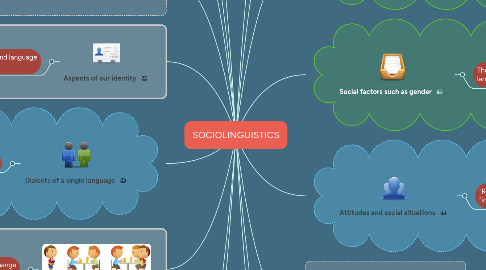SOCIOLINGUISTICS
by pilar vasquez

1. Language use interacts
1.1. Study of verbal behavior in terms of the social characteristics of speakers
2. Promoting cooperative learning as well as to incorporating
2.1. Fostering social interaction and cooperative learning in their teaching practice.
3. Interaction between social and/or societal factors and language.
3.1. Mainly oral but some written, are elicited from French-language and language-contact situations. ,copy; Walter de Gruyter.
4. Social factors such as gender
4.1. Their identity is less threatened by target language norms
5. Ethnicity
5.1. Common national or cultural tradition.
6. Students to improve their own learning process and their peers', based on mutual help
6.1. Interactions with other students that are supposed to deal with the same language level.
7. Age or social class
7.1. Group of people with similar levels of wealth, influence, and status
8. Describe and interpret the socially motivated
8.1. Able to adjust their speech
9. Aspects of our identity
9.1. Applied linguistics and second language learning.
10. Attitudes and social situations
10.1. "Representation" from "attitudes" and "ideologies."
11. Dialects of a single language
11.1. Particular region and/or social class
12. Rubén Chacón-Beltrán Sociology of language
13. Social behavior and human interaction
13.1. For example, role, hierarchy, exchange requirements,
14. Peter Trudgill, A Glossary of Sociolinguistics. Oxford University Press, (2003)
15. Hudson, Essential Introductory Linguistics. Blackwell, (2000)
16. (Trudgill, 1983)
17. The language use involves “Who speaks, what language, to whom, when and where” Fishman, 1972:244)


